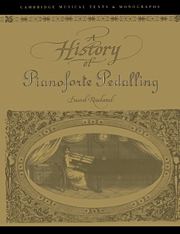Introduction
Published online by Cambridge University Press: 16 November 2009
Summary
The importance of the pedal as an adjunct to artistic piano playing can hardly be overestimated. It is not too much to say that the effect of almost all modern music (from the earliest compositions of Thalberg and Liszt) depends upon its skillful use, and yet no question of technic has been so much neglected. While touch has been analyzed in the most minute manner, every movement of finger, wrist and arm noted with the greatest accuracy, the study of the pedal, as Herr Schmitt remarks, has hardly gone beyond the standpoint of instinctive feeling on the part of the player.
This was Frederick Law's assessment in 1893, given in the introduction to his translation of Hans Schmitt's Das Pedal des Claviers (Vienna 1875). His remarks are entirely justified. Apart from some chapters of a rather general nature in nineteenth-century piano tutors, there had been no detailed study of the subject prior to Schmitt's. Consequendy, assessing the precise characteristics of the pedalling techniques of major nineteenth-century figures such as Liszt or Thalberg is far from easy, and it is still more difficult to discover the way in which the earliest pianists such as Mozart may, or may not, have used the devices which were common on pianos of their day.
Since the appearance of Schmitt's book towards the end of the nineteenth century a number of pedalling tutors have been published which explore the details of the instrument's mechanism as well as technique. More recently there has been a growing awareness of some historical aspects of the subject.
- Type
- Chapter
- Information
- A History of Pianoforte Pedalling , pp. 1 - 4Publisher: Cambridge University PressPrint publication year: 1993

